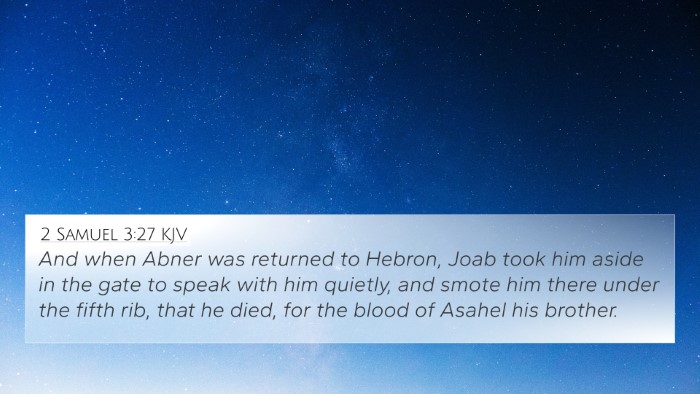Understanding Matthew 26:48
Matthew 26:48 states: "Now he that betrayed him gave them a sign, saying, Whomsoever I shall kiss, that same is he: hold him fast." This verse captures the moment when Judas Iscariot identifies Jesus to the chief priests and soldiers, facilitating His arrest.
Summary of Insights
This moment in the Gospels holds profound implications, not only for the immediate events that unfolded but also for the greater theological themes throughout Scripture. By examining the connections between Matthew 26:48 and various public domain commentaries, we can unravel deeper meanings and perspectives surrounding this pivotal scene.
Commentary Insights
-
Matthew Henry's Commentary:
Henry highlights the treachery of Judas and the culmination of Jesus's ministry leading to His arrest. The act of betrayal through a kiss—a sign of affection—underscores the depth of Judas's deceit. This paradox speaks to the nature of sin and the reality of betrayal even within close relationships.
-
Albert Barnes's Commentary:
Barnes discusses the significance of the kiss as a method of identification. He suggests that this act was designed to avoid confusion amidst the crowd, showing how deep the betrayal ran, as Judas employed a symbol of friendship to signify treachery.
-
Adam Clarke's Commentary:
Clarke elaborates on the context of this betrayal. He notes that Judas's actions fulfilled Old Testament prophecies, reflecting the nature of prophecy in the life of Jesus. This verse serves as a crucial link in God's redemptive plan through Christ's suffering.
Bible Verse Cross-References
To grasp the full implications of Matthew 26:48, we can draw upon several cross-referenced Bible verses:
- John 13:2: "And supper being ended, the devil having now put into the heart of Judas Iscariot, Simon's son, to betray him." This verse sheds light on the spiritual influences leading to Judas's betrayal.
- Psalms 41:9: "Yea, mine own familiar friend, in whom I trusted, which did eat of my bread, hath lifted up his heel against me." This Psalm prophetically aligns with the actions of Judas.
- Luke 22:48: "But Jesus said unto him, Judas, betrayest thou the Son of man with a kiss?" This verse provides Jesus’s poignant response to Judas’s act, illustrating the burden of betrayal.
- Matthew 26:14-16: "Then one of the twelve, called Judas Iscariot, went unto the chief priests, and said unto them, What will ye give me? And they covenanted with him for thirty pieces of silver." This background emphasizes Judas's motivations and the foreknowledge of Jesus regarding his betrayal.
- Zechariah 11:12-13: "And I said unto them, If ye think good, give me my price; and if not, forbear. So they weighed for my price thirty pieces of silver. And the LORD said unto me, Cast it unto the potter: a goodly price that I was prised at of them." A prophetic reference related to the thirty pieces of silver betrayed by Judas.
- Acts 1:16-17: "Men and brethren, this scripture must needs have been fulfilled, which the Holy Ghost by the mouth of David spake before concerning Judas, which was guide to them that took Jesus." Illustrates the fulfillment of prophecy concerning Judas’s role in the betrayal.
- Mark 14:43-45: "And immediately, while he yet spake, cometh Judas, one of the twelve, and with him a great multitude..." This account corroborates the events leading to Jesus's arrest, providing additional context and perspective on the betrayal.
Thematic Bible Verse Connections
Matthew 26:48 serves as a pivotal point in the narrative of Jesus's Passion, echoing themes of betrayal, prophecy, and redemption. Consider how this verse interplays with broader biblical themes such as:
- Betrayal and Loyalty: The stark contrast between Judas's betrayal and the disciples' loyalty enriches our understanding of human nature and fidelity.
- Fulfillment of Prophecy: This moment shows how New Testament events fulfill Old Testament predictions, encouraging readers to explore the interconnectedness of Scripture.
Inter-Biblical Dialogue
By analyzing the connections between Bible verses, one can glean insights into the nature of betrayal and its consequences, as illustrated in Matthew 26:48. This verse invites readers to reflect on how personal actions resonate within the larger narrative of God's plan for humanity. The art of Bible cross-referencing not only enhances understanding of specific verses but also enriches the entire biblical text.
Conclusion
Understanding the meaning of Matthew 26:48 involves a multi-faceted approach through comparative Bible verse analysis and thematic connections. Engaging with various commentaries provides depth and clarity, encouraging a holistic comprehension of the Scripture. By exploring cross-referenced themes, readers can uncover motivational influences, prophetic fulfillments, and the overarching narrative of betrayal leading to redemption.







